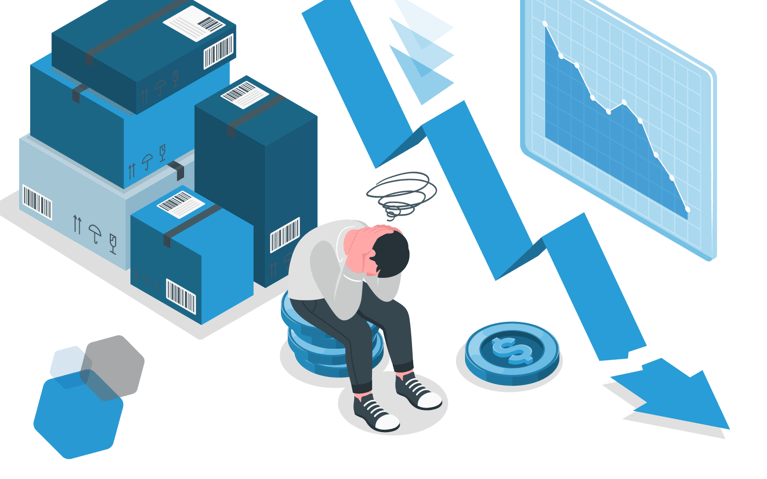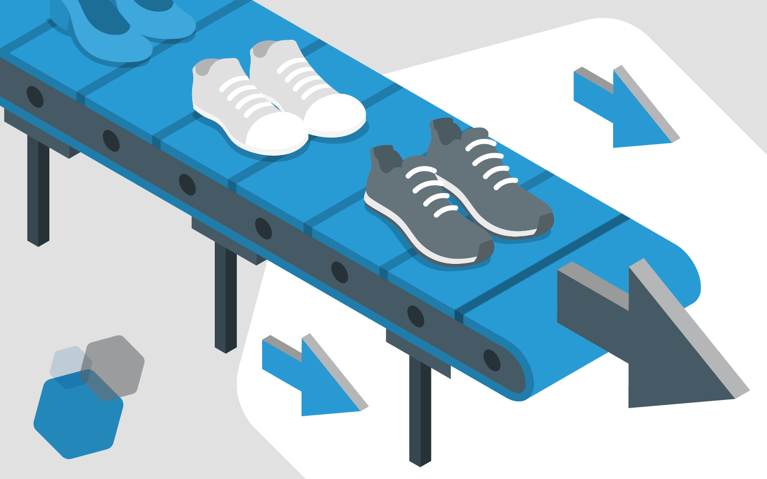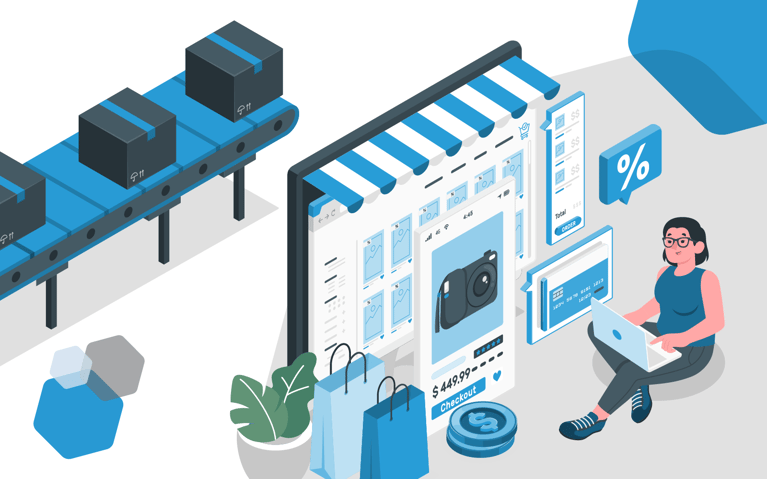The retail landscape in 2025 is more dynamic and fast-paced than ever, driven by rapidly changing consumer demands and cutting-edge technological advancements.
Today’s shoppers expect not only lightning-fast delivery but also eco-friendly practices and highly personalized experiences. Meanwhile, retailers are tasked with navigating economic uncertainty, labor shortages and an increasingly competitive market.
To thrive in this environment, retail leaders must adopt innovative strategies and tackle these challenges head-on. The following sections explore the key retail fulfillment obstacles of 2025 and offer actionable solutions to help businesses stay competitive and meet evolving customer expectations.
What is retail fulfillment?
Retail fulfillment is the process of managing inventory, fulfilling orders and delivering products to customers efficiently and accurately. It encompasses everything from receiving inventory in a warehouse to picking, packing and shipping orders to their final destination.
In today's fast-paced retail environment, fulfillment is not just about logistics—it's about meeting customer expectations for speed and accuracy.
Successful fulfillment can significantly impact a retailer's reputation, especially as consumers demand seamless experiences across channels.
7 Challenges and strategies defining retail fulfillment in 2025
As the retail industry grows more complex, businesses face an evolving set of challenges that demand innovative solutions. From leveraging cutting-edge technology to meeting consumer expectations for sustainability and personalization, retailers must tackle these obstacles head-on to remain competitive.
Advanced automation and robotics
Automation and robotics are no longer optional for retailers looking to optimize their fulfillment operations. In 2025, these technologies are positioned to become even more sophisticated and widely adopted.
AI-powered robots now handle tasks like sorting, packing and transporting goods within warehouses, while autonomous vehicles are revolutionizing last-mile delivery. These tools improve order accuracy by reducing human error and allow businesses to scale operations effortlessly during peak seasons.
Key strategies:
Adopting automation starts with understanding where inefficiencies exist in your current processes. To identify opportunities for improvement, organizations should:
- Conduct a thorough workflow assessment to identify bottlenecks
- Partner with vendors who specialize in AI-driven robotics to ensure solutions align with your unique operational needs
- Integrate automation tools with a robust warehouse management system (WMS) to streamline processes, ensuring you get the most value from your investment
- Begin with incremental changes, such as automating repetitive tasks, and gradually expand your use of robotics to include more complex operations
Data privacy and security
In 2025, transparent data practices are more critical than ever. As privacy regulations strengthen and consumers demand greater control over their data, retailers face heightened challenges in balancing personalization with security.
To protect sensitive customer information, retailers must implement robust cybersecurity measures, including encrypted transactions, multi-factor authentication and regular system audits.
Key strategies:
Businesses looking to build customer trust must start by fostering a culture of security within their organization. To accomplish this new internal mindset, companies should:
- Train employees to handle sensitive data responsibly and recognize potential threats
- Invest in advanced encryption tools to safeguard transactions
- Consider partnering with reputable cybersecurity firms to bolster your defenses
- Perform regular system updates and audits to address vulnerabilities proactively
Hyper-personalization in fulfillment
Today’s consumers crave personalized experiences, even at the fulfillment level. Hyper-personalization is about tailoring every aspect of the customer journey to individual preferences. For example, some customers prefer same-day delivery, while others prioritize sustainable packaging or personalized messaging in their orders.
Key strategies:
Leveraging the power of AI and machine learning can help organizations better understand customer preferences. For instance, predictive analytics can provide insights into buying behavior, enabling you to offer tailored delivery options and customized product recommendations.
Integrating these insights into your CRM and fulfillment systems allows you to create a seamless, personalized experience, opening opportunities to engage customers post-purchase with follow-up offers or personalized thank-you messages.
Labor shortages and automation
Labor shortages continue to challenge the retail industry in 2025 as businesses struggle to attract and retain workers. Rising wages and demands for flexible work schedules have made traditional staffing models less effective. As a result, retailers are increasingly turning to automation as a solution.
Key strategies:
While automation can alleviate staffing challenges, maintaining a skilled and motivated workforce is equally important. As a way to retain talent, organizations should:
- Offer employees ongoing training to help them adapt to new technologies and workflows.
- Provide flexible scheduling options
- Stay ahead of the marketplace for competitive pay
- Support their workforce with autonomous picking robots and AI-driven inventory management systems to maximize efficiency while minimizing strain on your team.
Omnichannel integration
Seamless integration across multiple sales channels is a cornerstone of modern retail fulfillment. In 2025, consumers expect a unified and frictionless shopping experience, whether they’re browsing your online store, purchasing in a physical location or engaging through social media platforms.
This demand for integration goes beyond convenience—it’s about creating a consistent brand experience that builds trust and loyalty. As retail ecosystems grow more complex, achieving true omnichannel alignment has become a top priority for businesses aiming to stand out in a competitive marketplace.
Key strategies:
One of the best options for organizations looking to improve their omnichannel ecosystem is implementing a cloud-based order management system (OMS). These multi-functional solutions centralize inventory and customer data, ensuring real-time synchronization across all channels.
This approach also enhances operational efficiency and provides customers with accurate information about product availability and delivery times.
Bonus Tip:
If your business has the resources, incorporating features like curbside pickup and flexible return options can help to create a cohesive shopping experience that fosters buyer loyalty.
Sustainable practices
In 2025, eco-conscious consumers expect businesses to minimize their environmental footprint without sacrificing quality or convenience. As a result, retailers are responding with innovative, greener fulfillment strategies.
Businesses are addressing environmental concerns by focusing on eco-friendly packaging materials, optimizing delivery routes to reduce emissions and partnering with suppliers who prioritize sustainable practices.
By integrating sustainability into their fulfillment processes, retailers can differentiate themselves in a crowded marketplace while contributing to global environmental goals. This dual focus on profitability and planet-friendly initiatives has made sustainability a competitive advantage in modern retail.
Key strategies:
Creating a company focused on sustainability doesn't happen overnight. Instead, making small but impactful changes is often the best route when looking to make your organization more green.
Below are a few simple steps your team can take on its sustainability journey:
- Adopt recyclable or biodegradable packaging materials
- Work with logistics providers that prioritize eco-friendly practices
- Explore carbon-offset programs to mitigate your environmental footprint
- Engage customers by offering slower, more sustainable shipping options
Inventory management and supply chain resilience
In 2025, efficient inventory management and a resilient supply chain are more critical than ever for retail success. Rapidly shifting market conditions, unexpected global events and evolving consumer demands require retailers to adapt swiftly to avoid disruptions.
Whether it’s responding to sudden demand surges or mitigating supply chain interruptions, businesses must prioritize agility and visibility to stay competitive.
A resilient supply chain isn’t just about weathering storms—it’s about thriving in uncertainty. Leveraging advanced technologies like IoT-enabled sensors and AI-driven forecasting tools can help retailers:
- Monitor inventory levels
- Anticipate potential bottlenecks
- Make proactive adjustments
Additionally, diversifying supplier networks and establishing micro-fulfillment centers closer to key markets can improve responsiveness and reduce shipping delays. By stress-testing supply chains regularly, retailers can identify and address vulnerabilities before they impact operations, ensuring they are prepared to meet customer expectations no matter what challenges arise.
Key strategies:
Organizations looking to build a resilient supply chain should focus on:
- Investing in tools that provide real-time visibility into supply chain operations
- Diversifying supplier bases
- Establishing micro-fulfillment centers near key markets to improve responsiveness
- Implementing IoT-enabled sensors and AI-driven forecasting tools to help predict potential issues before they escalate
- Conducting regular stress tests of the company's supply chain to identify vulnerabilities
Discover how Cart.com is helping organizations embrace the future of fulfillment
The challenges of retail fulfillment in 2025 are significant, but so are the opportunities. By embracing automation, prioritizing data privacy and adopting sustainable practices, retailers can create fulfillment strategies that meet customer expectations while positioning their businesses for long-term success.
Staying ahead of industry trends and continuously innovating will be the keys to thriving in this dynamic landscape. For retail leaders, the future of fulfillment isn’t just about keeping up—it’s about leading the way.
Contact our team today to learn how we can help your company navigate potential fulfillment challenges in 2025.
Subscribe to our emails for the latest industry insights!
By entering your email, you agree to receive marketing emails from Cart.com






